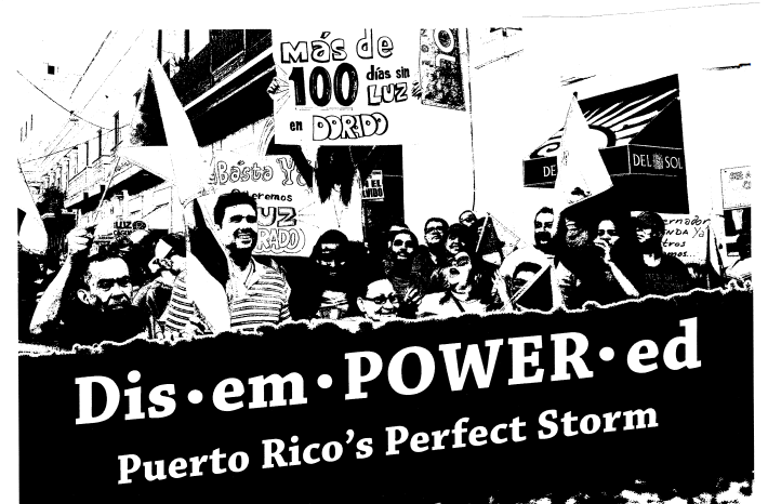 Ed. note: You can find out more about the film here.
Ed. note: You can find out more about the film here.
DisemPOWERed: Puerto Rico’s Perfect Storm
Directed, videographed and edited by Roque Nonini
Written, produced and narrated by Sandy Smith-Nonini
Associate Produced by Velda Modesti
Illustrated by Hana Fruchtenicht
Music by Blue Dot Sessions, Mystery Mammal, Kevin MacLeod, Tequila Moonrise, Kai Engel and Bomba Yo
Funded by donations from Sandy Smith-Nonini, Donald Nonini, Sandy Demeree, Orin Starn, Dominic Boyer, Colin Levy, Boo Walukas, Avery McEvoy and various anonymous donors
Release Date: Aug. 2019
Running time: 52 minutes
Hurricane Maria’s takedown of the Puerto Rican power grid in September 2017 brought modern life to a standstill across the island. Many regions remained without electricity for months, and some for nearly a year. A large share of the more than 3,000 deaths caused by Maria came from lack of access to basic necessities. There was, however, one notable haven from the widespread mayhem. In the town of Adjuntas lies a place called Casa Pueblo (Spanish for Town House), which for the past 20 years has been powered completely by solar energy. Casa Pueblo is a nonprofit that models and advocates for community solar, and during Maria’s aftermath it was a lifeline for people who came by to recharge their phones, power medical devices, contact family and stay informed about the news.
The difference between Casa Pueblo’s shining example and the bleak energy reality faced by Puerto Ricans at large is the main lament of the documentary DisemPOWERed. Written and produced by anthropology and Latin American studies professor Sandy Smith-Nonini, this indie film is a meticulously researched, densely informative—yet accessible—exposé of Puerto Rico’s economic, political and energy woes. It shows how an impoverished economy, an ailing power grid, a deeply troubled utility and a long history of colonial exploitation by the United States all conspired with a behemoth hurricane to bring about the worst blackout in U.S. history. The film warns that Puerto Rico will face many more such storms as climate change intensifies. However, it believes in the power of grassroots citizens’ movements like Casa Pueblo to fortify the island’s energy system against these weather events. The documentary’s ideal is a democratically, renewably powered Puerto Rico with an empowered populace.
The film’s title has multiple levels. Aside from its word play with “power” (alluding to both a lack of political influence and an absence of electricity), it conveys the inability of most Puerto Ricans to choose where their energy comes from. The vast majority of the island’s residents, we learn, are dependent on a single, badly mismanaged electric utility known as the Puerto Rico Electric Power Authority, or PREPA. Those who try to obtain their energy from elsewhere are penalized by the government. As Juan Rosario, former public representative on PREPA’s board, starkly puts it, “I think they [the government] want to keep controlling the energy so they can keep controlling the people.”
Work on this film began in Maria’s immediate aftermath, when Smith-Nonini, a former journalist, became obsessed with the crisis in Puerto Rico and endeavored to learn all she could about its roots. As she delved into her research, she got to talking with her son, filmmaker Roque Nonini, about traveling to the island to make a documentary. Nonini was interested and signed on as director. He originally conceived of their project as a 20-or-so-minute short, but as the two of them progressed, they realized that the story they were uncovering was too complex to be told so quickly. It turned out that Puerto Rico’s blackout was deeply intertwined with the territory’s debt crisis, its economic dependence on the United States and the corrupt dealings of PREPA. To gain insight into this quagmire, the filmmakers made three trips to Puerto Rico and interviewed academics, news reporters, former PREPA officials, activists and alternative energy entrepreneurs, among others.
The film’s opening montage cuts among these interviews, footage of Maria’s devastation, interviews with local residents picking themselves back up in its wake and video of the spirited May Day protest demonstrations held in Puerto Rico’s capital, San Juan, earlier this year. One of the more trenchant moments in this sequence comes when University of Puerto Rico economics professor José Caraballo Cueto describes how Puerto Rico’s colony status lends itself to exploitation. “If you have a colony,” he says, “you can do whatever you want. You don’t have to respect anything.” Alluding to the fact that Puerto Ricans, despite being U.S. citizens, can’t vote for president and have no congressional representatives, he adds, “You don’t have people with voting power.” As he explains this, the film moves to a shot of a political poster declaring “ESTA ‘DEMOCRACIA’ NO LA ENTENDEMOS”—which translates to “WE DO NOT UNDERSTAND THIS ‘DEMOCRACY.'” Juxtapositions like this make DisemPOWERed a master class in poignant film editing.
The interviews with everyday residents are particularly impactful. One woman describes how her family was economically ruined by the loss of their home—which they had begun building only a year and a half earlier—and then spent weeks scrounging for food and water, which were nowhere to be found in stores. Others recall how ATMs and cell phones became useless and people began counting the days without electricity. Even those with generators and the means to fuel them generally couldn’t keep them running for entire days, given that gasoline rationing was in effect. An island suddenly came to feel like an incomprehensible abyss.
Puerto Rico’s high poverty rate and beleaguered public health system go a long way toward explaining why the blackout’s death toll was so staggering. We’re informed that in 2015, the island’s poverty rate was twice that of the poorest state, Mississippi, and yet it received far less federal funding than any U.S. state for its social and public health needs. Puerto Rico also has a large number of people with chronic conditions, and for these individuals the blackout became immediately life threatening. A woman with diabetes tells of how she had to throw away four bottles of insulin because her refrigerator wasn’t working and she couldn’t keep her cooler stocked with ice. A hospital worker remembers with anguish how a cancer patient suffered tremendous pain for two months because the machine used to administer her pain-relief medication stopped running. Those requiring respiratory therapy or kidney dialysis also had to forego treatment.
How could it take so long for a territory of a modern industrial nation to regain electricity? DisemPOWERed answers this question through expert interviews, article citations shown at the bottom of the screen and Smith-Nonini’s erudite narration. A core reason was the bankrupt status of both PREPA and the Puerto Rican government, which severely limited their ability to mount a response to Maria. Matters worsened when PREPA’s then-chief executive made the controversial decision to award a $300 million power restoration contract to tiny, little-known Montana company Whitefish Energy. A month later, with most of the island still lacking power, he ended the contract and announced that its cancellation would delay power restoration by 10 to 12 weeks. The U.S. Army Corps of Engineers then took over, but progress was slowed by parts shortages and administrative delays. Another big problem lay in the fact that Puerto Rico’s power grid was built for industrial, not residential, uses.
Understanding how Puerto Rico became so deeply indebted requires a look back in history, and to this end DisemPOWERed provides an illuminating survey of the territory’s economic history over the past 80 years. It begins with Operation Bootstrap, a New Deal-type initiative that brought industrialization and the appearance of prosperity to Puerto Rico, even as it made Puerto Ricans dependent on American agricultural exports and drove scores of unskilled workers to look for work on the mainland. From there it looks at how Puerto Rico’s removal from the U.N.’s list of non-self-governing territories in the 1950s failed to usher in a bold new era of democratic autonomy for Puerto Rico. The film also exposes how the Jones Act has doubled Puerto Rico’s spending on imported goods from the mainland compared to other Caribbean islands, due to a penalty on all goods that don’t come on U.S. ships staffed by all-U.S. crews.
Operation Bootstrap, despite being touted as a great boon for Puerto Rico, didn’t help the territory establish its own industries; rather, it enticed mainland manufacturers to do business on the island through tax breaks. These eventually went away, however, and between their expiration and the establishment of a North American free trade zone, U.S. companies became incentivized to do business elsewhere. Thus began the long economic decline of both Puerto Rico and PREPA. With the departure of U.S. mainland companies, PREPA lost its best customers, the island as a whole hemorrhaged jobs and population and its government became bankrupt to the tune of more than $70 billion, without the option (until recently, that is) of declaring bankruptcy. In 2016, Congress instituted a control board to help manage Puerto Rico’s debt, but it has mostly imposed austerity measures such as the closing of schools and hospitals.
Puerto Rico is highly oil-dependent, and DisemPOWERed argues that this fact partly explains PREPA’s substantial debt—which accounts for $9 billion of the territory’s grand total—and its rationale for borrowing. By way of graphics, the film shows us that Puerto Rico generated 65 percent of its electricity with oil at the outset of its debt crisis, and that the majority of PREPA’s operating expenses go toward fuel purchases. When oil prices began their meteoric rise during the 2000s, PREPA passed the extra cost along to consumers and began receiving government subsidies to pay for the ever-more-expensive oil. High oil prices also meant that even as Puerto Rico faced bankruptcy in 2015, it was essentially “exporting borrowed money to pay for oil,” says Smith-Nonini. According to researchers at the University of Puerto Rico, as much $8 million was leaving the island every day in the form of fuel purchases.
This review has only grazed the surface of the myriad issues explored in DisemPOWERed. From the intricacies of Puerto Rico’s internal political landscape, to the factors driving its bond debt crisis, to PREPA’s fuel-buying scandal, to the bungled government response to Hurricane Maria, DisemPOWERed is chock full of rich detail and contextual material on a wealth of subjects vital to understanding what led up to the island’s great blackout. That the film covers so much ground in less than an hour is perhaps its most laudable virtue.
The documentary’s concluding section finds cause for both hope and despair. On one hand, it takes heart from the increasing feasibility of renewable energy sources, together with recent legislation by the Puerto Rican government to incentivize the development of these resources. On the other, it decries Puerto Rico’s overwhelming reliance on bandage solutions to its crisis and the profit-motive imperative that has long held back a concerted transition to renewables. What I most admire about the ending is that it’s willing to pose challenging questions—for example, “What does sustainability mean for Puerto Rico?”—and leave them open rather than supplying facile, tidy answers to them.






